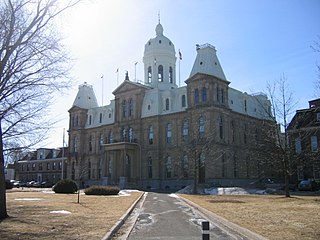
In the United Kingdom, a scheduled monument is a nationally important archaeological site or historic building, given protection against unauthorised change.
In the broadest sense, cultural resource management (CRM) is the vocation and practice of managing heritage assets, and other cultural resources such as contemporary art. It incorporates Cultural Heritage Management which is concerned with traditional and historic culture. It also delves into the material culture of archaeology. Cultural resource management encompasses current culture, including progressive and innovative culture, such as urban culture, rather than simply preserving and presenting traditional forms of culture.
Environment and Climate Change Canada, is the department of the Government of Canada responsible for coordinating environmental policies and programs, as well as preserving and enhancing the natural environment and renewable resources. It is also colloquially known by its former name, Environment Canada.
The Ministry of the Environment, Conservation and Parks is an Ontario government ministry responsible for protecting and improving the quality of the environment in the Canadian province of Ontario, as well as coordinating Ontario's actions on climate change. This includes administration of government programs, such as Ontario's Drive Clean and Clean Water Act. The ministry headquarters are located inside the Ontario Government Buildings.
The Ontario Municipal Board (OMB) was an independent administrative board, operated as an adjudicative tribunal, in the province of Ontario, Canada. It heard applications and appeals on municipal and planning disputes, as well as other matters specified in provincial legislation. The tribunal reported to the Ministry of the Attorney General from 2012 until its shuttering. The Board had been criticized for its broad powers and authority to override the Planning Act decisions of municipal councils.
Ontario Parks is the Ontario government agency in Ontario, Canada, that protects significant natural and cultural resources in a system of parks and protected areas that is sustainable and provides opportunities for inspiration, enjoyment and education. The Ontario Parks system covers over 78,000 square kilometres (30,000 sq mi), which is about 10 percent of the province's surface area or the equivalent of an area approximately equal to Nova Scotia. It falls under the responsibility and mandate of the province's Ministry of the Environment, Conservation and Parks. It was formerly under the mandate of the Ministry of Natural Resources and Forestry.

Environmental Impact assessment (EIA) is the assessment of the environmental consequences of a plan, policy, program, or actual projects prior to the decision to move forward with the proposed action. In this context, the term "environmental impact assessment" (EIA) is usually used when applied to actual projects by individuals or companies and the term "strategic environmental assessment" (SEA) applies to policies, plans and programmes most often proposed by organs of state. It is a tool of environmental management forming a part of project approval and decision-making. Environmental assessments may be governed by rules of administrative procedure regarding public participation and documentation of decision making, and may be subject to judicial review.
The Bradford Bypass, also known as the Highway 400–404 Link is a proposed east–west 400-series highway in the northern Greater Toronto Area of the Canadian province of Ontario. The approximately 16.2-kilometre (10.1 mi) route is currently undergoing planning and analysis under an environmental impact assessment (EA) by the Ministry of Transportation of Ontario (MTO) and the Government of Ontario. If approved, a new four-lane controlled-access highway would be built between Highway 400 near Bradford in Simcoe County, and Highway 404 near Queensville in York Region. It would serve as a bypass to the north side of Bradford.
Manitoba Sport, Culture and Heritage is the department of the Government of Manitoba responsible for managing government programs and services that support the sport, art, culture, and heritage of the province, through developing, supporting, promoting, and celebrating the identity and well-being of Manitoba and its communities.

British Columbia Archaeological Assessment Process: British Columbia has set forth a directive process in order to regulate the development of land by private and government identities, this is known as the Heritage Act. British Columbia holds cultural sites throughout its geography and is home to many famous aboriginal archaeological sites, such as the Kwäday Dän Ts'ìnchi, which was an archaeological site containing a frozen person in British Columbia's Tatshenshini-Alsek Park. British Columbia archaeological sites are held in accordance with both the Heritage Act and the federal Environmental Assessment Act, which regulates the areas where developers can utilize and where the provincial government can build infrastructure. This process has not been put into place to discourage development, but has been put into place to regulate historic cultural sites in order to retain historic areas, sites, ecofacts, and artefacts.

Archaeology in Saskatchewan, Canada, is supported by professional and amateur interest, privately funded and not-for-profit organizations, and governmental and citizen co-operation with the primary incentive to encourage archaeological awareness and interest in the heritage that defines the province to this date. The landscape of Saskatchewan hosts substantial prehistoric and historic sites.
The Ontario Trails Council (OTC) is a charitable organization which promotes the management, use, preservation and development of recreational trails and trail based activity, in Ontario, Canada.

Heritage Western Cape (HWC) is a provincial heritage resources authority established by the Minister of Cultural Affairs and Sport of the government of the Western Cape province in South Africa. It is a public entity set up under the terms of the National Heritage Resources Act. It is mandated to care for that part of South Africa's national estate that is of provincial and local significance in the Western Cape. It may delegate responsibility for heritage resources of local significance to competent municipal governments.

The Heritage Conservation Act is a provincial statute which allows for the preservation of cultural heritage properties and areas in the province of New Brunswick, Canada.

ASI is the largest private archaeological and cultural heritage consulting company in Ontario, with offices in Toronto and Burlington. The company is a part of the Cultural Resource Management (CRM) industry.

The Heritage Property Act is a provincial statute which allows for the preservation of cultural heritage properties, archaeological sites and palaeontological sites in the province of Saskatchewan, Canada.

Grimsby GO Station is a proposed commuter rail station on the GO Transit train and bus network in Southern Ontario, Canada. Located in the town of Grimsby in the Regional Municipality of Niagara, it would be a stop on the Lakeshore West line, east of the proposed Confederation GO Station in Hamilton. It was expected to open in 2021 and would have been the first station to open in the planned Niagara extension, which will also include stops at St. Catharines and Niagara Falls stations.

The 42nd Legislative Assembly of Ontario was a legislature of the government of the province of Ontario, Canada. The membership was set by the 2018 Ontario general election and sat for two sessions until it was dissolved on May 3, 2022 in advance of the 2022 Ontario general election.










